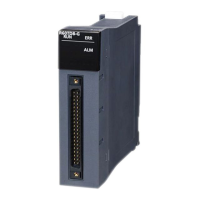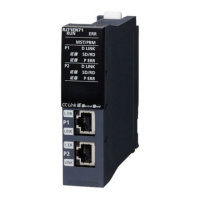876
APPX
Appendix 5 List of Special Register Areas
SD1644 Cause of system
switching failure
Cause number of
system switching
failure
• If a system switching is failed because a cause of system
switching failure has occurred, either of the following values is
stored in this register.
0: System switching completed normally (default)
1: Tracking communications disabled
2: Tracking communication timeout
3: Stop error of the standby system
4: Operating status mismatch between both systems
5: Memory copy being executed
6: Online change being executed
7: A failure of a network module detected on the standby system
8: System switching being executed
9: A redundant function module being changed online
10: System switching disabled on the standby system by using the
DCONTSW instruction
14: Safety operation mode mismatch between both systems
15: A failure of safety tracking data detected
• This register is initialized with 0 when own system is powered on.
• Zero is stored in this register upon completion of system
switching.
S (At system
switching)
RnP
RnPSF
SD1645 System switching
request status from a
network module of
own system
System switching
request status from a
network module of
own system
• The system switching request status from a network module of
the own system is stored using the following bit pattern. (The bits
of the positions where no modules are mounted turn off.)
b0 to b11: Slot No.0 to slot No.11
• The system turns off the bit after the error in the corresponding
module is removed by a user.
• For the system switching request status from a network module
of the other system, refer to SD1646.
S (Error/Status
change)
RnP
RnPSF
SD1646 System switching
request status from a
network module of
the other system
System switching
request status from a
network module of
the other system
• The system switching request status from a network module of
the other system is stored using the following bit pattern. (The
bits of the positions where no modules are mounted turn off.)
b0 to b11: Slot No.0 to slot No.11
• The system turns off the bit after the error in the corresponding
module is removed by a user.
• For the system switching request status from a network module
of the own system, refer to SD1645.
S (Every END) RnP
RnPSF
SD1648 Cause of the other
system monitoring
error
Cause of the other
system monitoring
error
• When an error has occurred on the communications with the
other system during an initial processing (including when the
system is determined while waiting for the other system starts
up) or an END processing, either of the following bits turns on.
Once the error is cleared, the bit turns off.
b0: Communications with the other system disabled (other than a
redundant function module hardware failure in own system)
b1: Power-off, reset, or hardware failure (the CPU module or the
redundant function module) in the other system
b2: Stop error in the other system
b15: Communications with the other system disabled (a redundant
function module hardware failure in own system)
• If either of b0, b1, b2 or b15 is on, the other bits are off.
• When the communications with the other system is disabled at
an initial processing (including when the other system is powered
off), b0 turns on. (When power-off or reset of the CPU module in
the other system is recognized, b1 turns on.)
• The tracking cable status of when one of the above mentioned
bits of this register is on can be checked in SD1755.
S (Initial/every
END)/system
switching
RnP
RnPSF
No. Name Data stored Details Set by
(setting
timing)
CPU
b11
b0
b11
b0
b15 b1b2
b0

